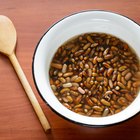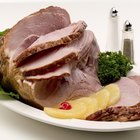
One of pork's most ingratiating characteristics is its affinity for salt and smoke. Cured pork is used in many forms to add flavor and richness to dishes, from the salt pork in Boston baked beans to the ham hocks that enliven so many Southern dishes. The two have many shared characteristics and can be substituted for each other in many recipes, but the flavor of the finished dish will be noticeably altered.
Getting Into Hock
Ham hocks are very similar to hams. The hock is the very bottom of the hog's leg, cut away from the shank end of the ham. It corresponds to the shanks in lamb or veal, and like those cuts, a ham hock is filled with tough muscle and stringy tendons. They're usually cooked through long and slow simmering, which renders out the hocks' fat and dissolves the connective tissues into natural gelatin. At the end of its cooking time, the hock itself is as lusciously tender as a good pot roast, and the dish it's cooked in is infused with richness and flavor.
What it Brings to the Table
A ham hock usually contains skin, bone and connective tissue as well as its flavorful flesh. All of those have an impact on the finished dish. The bones, skin and connective tissues are rich sources of natural gelatin, which give the cooking broth body and a silky-smooth mouth feel. The briny flavor of the hock seasons the broth and the smoke lends it a distinctive flavor. The combination of salt and smoke complements the flavors of any other ingredients cooked in the same dish, such as beans, greens or sturdy root vegetables.
A Big Fat Belly
The most common variety of salt pork is pork belly, which is much like bacon, but fattier. Other, meatier forms of salt pork such as pickled riblets are sometimes available regionally, but are less common. While ham hocks and bacon are cured with a mixture of salt and sugar, salt pork is usually packed in salt alone, and lots of it. It can last for years when packed in brine. Meaty riblets are usually soaked before cooking to remove some of the salt, but fatty salt pork typically is not.
The Salt Pork Substitution
If your recipe calls for a ham hock, using salt pork as a substitute will change the end result in a few ways. Salt pork is boneless and seldom has a piece of skin attached, so it infuses the dish with less gelatin. It's saltier, so you can't use as much in the dish. The fat from the pork emulsifies into the broth and lends a degree of richness, along with the flavors from the lean streaks of pork flesh that run through the salt pork. The biggest difference is the lack of a ham hock's smoked flavor. However, the less assertive flavor of the salt pork leaves more focus on the beans or vegetables in the dish.
Related Articles

How to Cook With Pork Jowl

How to Make Salt Brine
How to Boil Pork Jowl Bacon

What Is Gray Salt?
How to Remove a Salty Taste From Sliced ...

How to Cook October Beans

How to Cook Pork & Sauerkraut in an ...

How to Do Corned Pork

Does Boiled Ham Have Nitrites?

Are Pork and Beans a Good Source of ...

The Effect of Salt on the Tenderness of ...

How to Buy the Best Spare Ribs at the ...

How to Brine a Boston Butt

Salt Vs. Non-Iodized Salt

How to Cook Pork Hamonado

Vegetables That Contain Salt

How to Carve a Spiral Cut Ham

How to Cook Lamb Without It Smelling Bad

How Do I Roast a Picnic Ham?

How to Brine Pork Leg
References
- On Food and Cooking: The Science and Lore of the Kitchen; Harold McGee
- The Kitchn: Less Meat, More Flavor -- Salt Pork
- The Cook's Thesaurus: Ham
- The Cook's Thesaurus: Bacon
Writer Bio
Fred Decker is a trained chef and prolific freelance writer. In previous careers, he sold insurance and mutual funds, and was a longtime retailer. He was educated at Memorial University of Newfoundland and the Northern Alberta Institute of Technology. His articles have appeared on numerous home and garden sites including GoneOutdoors, TheNest and eHow.
Photo Credits
Jupiterimages/Stockbyte/Getty Images